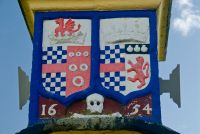
Her mother was her staunch ally in her struggle to regain what she believed was hers by right, though she never saw the final outcome, for she died shortly after their last meeting.
In 1643, after 29 years of legal wrangling, Lady Anne won her court case and became the owner of her father's large Cumbrian estates. The pillar marks the location near the gates to the Brougham Castle grounds where she last parted from her mother. It is a simple column of stone topped by a painted, four-faceted sundial, topped with a gilded cupola.
Beside the Countess Pillar is a flat stone where alms were given to poor of the parish each year on the anniversary of Lady Anne's parting from her mother. Both Lady Anne and her mother are buried in the parish church of Appleby.
Note:
The tricky part of visiting the Countess Pillar is actually finding it! The pillar is immediately beside the busy A66 and can be reached only via a permitted footpath parallel with the roadway (thankfully protected by trees from the worst of the traffic noise). The footpath begins at a pull-by created by a new exit off the A66 onto the B6262 to Brougham. It is not at all easy to see the pull-by when exiting the A66 (it's on your left).
One easier option is to park at nearby Brougham Castle (English Heritage) and walk the short distance to the beginning of the footpath.







 We've 'tagged' this attraction information to help you find related historic attractions and learn more about major time periods mentioned.
We've 'tagged' this attraction information to help you find related historic attractions and learn more about major time periods mentioned.



